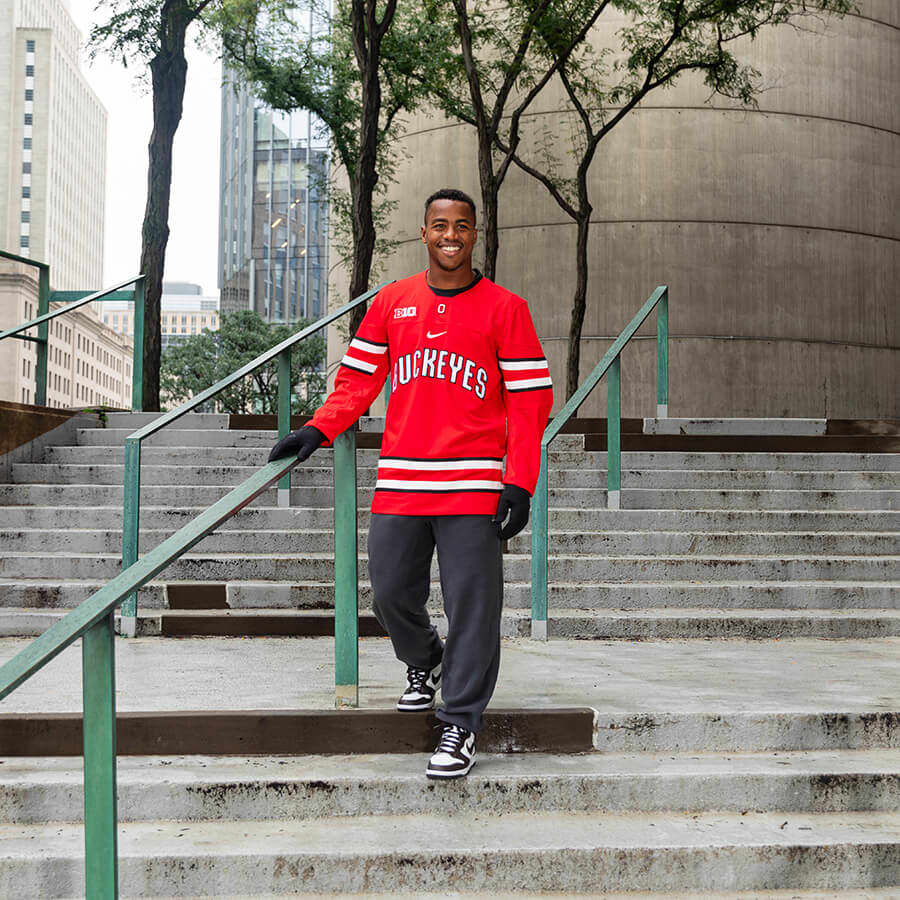Wearing the right gear under a hockey jersey is crucial. It affects comfort and performance on the ice.
Hockey is a demanding sport. Players need to stay comfortable and protected. Choosing the right under-jersey clothing helps with both. You don’t want to feel too hot or too cold. The correct base layers also protect against chafing and injuries.
Whether you’re a beginner or a seasoned player, knowing what to wear can make a big difference. This guide will help you understand the best options. From base layers to socks, each piece has a role. Let’s explore how to dress properly for your next game.

Credit: www.seattletimes.com
Choosing The Right Base Layer
Finding the right base layer to wear under a hockey jersey is essential. It ensures comfort and enhances performance on the ice. A good base layer manages moisture, provides warmth, and allows for freedom of movement. Let’s explore the key factors to consider.
Material Options
The material of the base layer plays a crucial role. Synthetic fabrics like polyester and spandex wick moisture away from the skin. They keep you dry and comfortable during intense games. Merino wool is another great option. It regulates temperature and resists odor. Cotton, on the other hand, is not ideal. It retains moisture and can make you feel cold and damp.
Fit And Comfort
The fit of your base layer should be snug but not restrictive. A proper fit ensures that the fabric does its job effectively. It should allow for easy movement. Avoid loose or baggy base layers. They can bunch up and cause discomfort. Look for flat seams to reduce chafing. Soft, stretchy materials add to the overall comfort. Always try on different options to find the best fit for you.

Credit: www.nike.com
Insulating Layers For Warmth
Choosing the right insulating layers for warmth is crucial when playing hockey. The rink can get quite cold, and staying warm is essential for comfort and performance. An effective insulating layer keeps you warm without restricting your movement. This balance is key to maintaining agility and staying focused during the game.
Types Of Insulating Layers
There are several types of insulating layers you can wear under your hockey jersey. Each type offers different benefits. Let’s explore the most common ones.
Thermal Shirts: Thermal shirts are a popular choice. They trap body heat and keep you warm. They are lightweight and fit snugly under your jersey.
Compression Tops: Compression tops provide warmth and support. They help improve blood circulation and muscle performance. They are also designed to wick away sweat, keeping you dry.
Fleece Layers: Fleece layers are great for extremely cold conditions. They offer excellent insulation and are very soft and comfortable. However, they might be a bit bulkier than other options.
Balancing Warmth And Mobility
It’s important to balance warmth and mobility. Wearing too many layers can restrict your movement. This can affect your performance on the ice.
Choose layers that provide warmth without adding bulk. Look for materials that offer insulation and flexibility. This way, you can stay warm and move freely.
Consider your personal comfort and the rink temperature. You might need to adjust your layers based on these factors. Finding the right balance will help you stay comfortable and focused during the game.
Protective Gear Considerations
Wearing the right protective gear under a hockey jersey is crucial. It ensures both comfort and safety on the ice. Choosing the right padding and ensuring it fits well under the jersey can make a big difference. Let’s explore the key protective gear considerations.
Padding And Protection
Padding is essential for shielding your body from hits and falls. The right padding can reduce the risk of injuries. Here are some key items to consider:
- Shoulder Pads: These protect the shoulders and chest. They should be snug but not too tight.
- Elbow Pads: They guard the elbows from impacts. Make sure they cover the entire elbow area.
- Shin Guards: These protect the lower legs. They should extend from the knee to the top of the skate.
- Pants: They cover the hips and thighs. Look for pants with built-in padding.
Compatibility With Jersey
Ensuring your protective gear fits well with your jersey is important. The gear should not restrict movement or feel bulky. Here are some tips for achieving compatibility:
- Size: Choose a jersey size that accommodates your padding. It should fit comfortably over all gear.
- Flexibility: Your jersey should allow full range of motion. Ensure it does not bind or bunch up.
- Material: Look for breathable and stretchable fabrics. This helps with both comfort and performance.
Refer to the table below for a quick guide on choosing the right gear:
| Protective Gear | Key Feature | Considerations |
|---|---|---|
| Shoulder Pads | Chest and Shoulder Protection | Snug Fit, Full Coverage |
| Elbow Pads | Elbow Impact Protection | Full Elbow Coverage, Secure Fit |
| Shin Guards | Lower Leg Protection | Knee to Skate, Comfortable Fit |
| Pants | Hip and Thigh Protection | Built-in Padding, Flexible Material |
Choosing the right protective gear and ensuring compatibility with your jersey can enhance your game. It provides the necessary protection while maintaining comfort and flexibility. Make sure to select the right size and materials for the best experience on the ice.
Moisture-wicking Fabrics
Choosing the right clothing to wear under a hockey jersey is essential. One key element to consider is moisture-wicking fabrics. These fabrics help keep you dry and comfortable during intense games. Let’s explore the benefits and popular choices.
Benefits Of Moisture-wicking
Moisture-wicking fabrics pull sweat away from your skin. This keeps you dry and reduces the risk of rashes. Staying dry also helps regulate your body temperature. This is crucial during intense physical activity. These fabrics are often lightweight. This adds to your comfort on the ice.
Popular Fabric Choices
Polyester is a common choice. It is durable and effective at wicking moisture. Another popular option is nylon. It is smooth, stretchy, and quick-drying. Spandex is often blended with other materials. It adds flexibility and comfort. Each of these fabrics offers unique benefits. They all aim to keep you dry and comfortable under your hockey jersey.
Seasonal Layering Strategies
Understanding what to wear under a hockey jersey involves mastering seasonal layering strategies. Wearing the right layers can enhance comfort, performance, and enjoyment. Whether the weather is freezing cold or warm, there are key adjustments to consider.
Cold Weather Tips
Layering is critical during cold weather. Start with a moisture-wicking base layer to keep sweat away from the skin. A thermal shirt can provide added warmth without bulk. Avoid cotton as it retains moisture and may lead to feeling colder.
Consider wearing a fleece or light jacket under the jersey. This adds insulation without restricting movement. Gloves and a hat are also useful, especially if playing outdoors.
Warm Weather Adjustments
In warm weather, staying cool is the priority. Opt for a lightweight, breathable base layer. This helps wick sweat and keeps the body dry. Avoid heavy or thick fabrics that can cause overheating.
Choose mesh or ventilated jerseys for better air circulation. Keep layers minimal to prevent overheating. Hydration is also key, so drink plenty of water. These adjustments can make a significant difference in comfort and performance.

Credit: www.tiktok.com
Frequently Asked Questions
What Should I Wear Under A Hockey Jersey?
Wear a moisture-wicking base layer. It keeps you dry and comfortable.
Can I Wear A T-shirt Under My Hockey Jersey?
Yes, a T-shirt is fine. But a base layer is better.
Is A Compression Shirt Good Under A Hockey Jersey?
Yes, a compression shirt works well. It supports muscles and manages sweat.
Do I Need Special Pants Under A Hockey Jersey?
Hockey pants or shorts with padding are best. They protect your hips and thighs.
Should I Wear Pads Under My Hockey Jersey?
Yes, wear shoulder pads. They provide protection and fit under your jersey.
Are Long Sleeves Necessary Under A Hockey Jersey?
Long sleeves are not necessary. But they can help wick sweat and protect skin.
Can I Wear A Hoodie Under A Hockey Jersey?
A hoodie is too bulky. It restricts movement. Stick to a base layer.
Do Professional Players Wear Base Layers Under Jerseys?
Yes, most pros wear base layers. It helps with sweat and comfort.
What Material Is Best For A Base Layer Under A Jersey?
Synthetic materials like polyester are best. They wick moisture and dry quickly.
Conclusion
Choosing the right clothing under your hockey jersey is crucial. It ensures comfort and mobility. Always opt for moisture-wicking fabrics. These keep you dry and cool. Compression shirts provide support and prevent chafing. Padded shirts add extra protection. Layering properly will enhance your performance.
Remember, the key is balance. Stay comfortable and protected, so you can focus on the game. Now, gear up and enjoy playing hockey!



